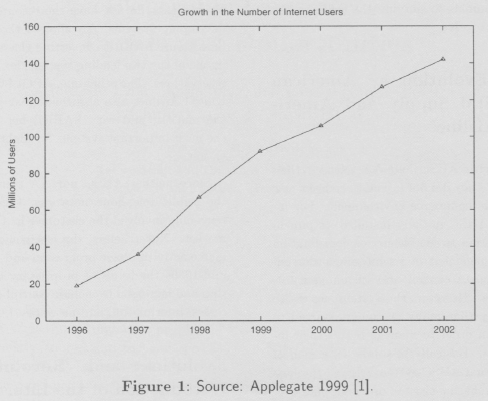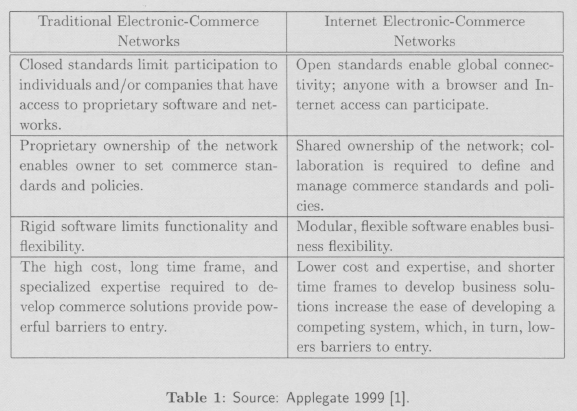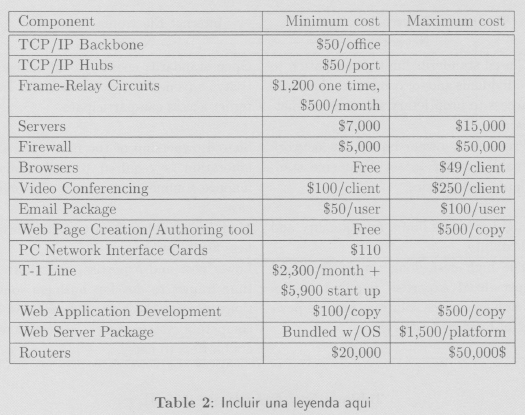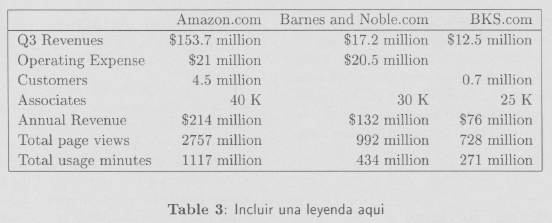Services on Demand
Journal
Article
Indicators
-
 Cited by SciELO
Cited by SciELO -
 Access statistics
Access statistics
Related links
-
 Similars in
SciELO
Similars in
SciELO
Share
Acta Nova
On-line version ISSN 1683-0789
RevActaNova. vol.1 no.4 Cochabamba June 2002
Universidad Empresa & Sociedad
Electronic Commerce: Trends and Opportunities
Juan de Dios Banda Jara, Jean Jerry Ralph Cadet, Chunyu Li, and Achyut Desai
University of Illinois at Chicago
Information and Decisions Sciences Department
Management Information Systems Masters Program
Introduction
In the last century the telephone caused profound changes in the whole society because it helped to communicate people and consequently to redefine the way people made business. The use of telephones along with other technologies such as production machinery, transportation, electricity, and the telegraph produced the change from an agricultural to an industrial economy. Even more important, telephones and the other technologies accelerate the shift from craft-based work to mass production, and the appearance of vertically integrated multinationals that replaced the small owner-operated firms.
Nowadays we live in a much more technological world than a century ago. Technologies today make possible that people from almost every remote spot in the world can access information using the Internet, and like a century ago, this phenomenon will redefine once again business models.
Similarly to the telephones in the past century, Internet does not represent an isolated technological discovery. Instead, Internet represents the integration of a whole collection of new and revolutionary technological innovations that have evolved over the years and that now converge in a new business concept: electronic commerce.
Once we have stated the importance of the presence of Internet, we will continue analyzing in the rest of the paper the impact of this on industries and markets.
The Evolution of Inter-organizational Systems
Back in 1966 the concept of inter-organizational systems (IOS) appeared an it implies the possibility that networked computers enable companies to share information; moreover, IOS involves the possibility to make business electronically crossing in this way organizational boundaries.
This crossing of organization boundaries through the IOS implied that new distribution channels can be created, and new information-based products can be delivered. Moreover, "Many IOS radically alter the balance of power in buyer-supplier relationships, raise barriers to entry and exit, and, in many instances, shift the competitive position of industry participants" [1].
The pioneers in the use of IOS were two companies. First, American Hospital Supply Corporation (AHSC) that created a system that allowed the company to exchange order-processing information with its customers across telephone lines. And second, American Airlines (AA) that offered to large travel agencies computerized reservation terminals to simplify the airline reservation process.
IOS Evolution at American Hospital Supply and American Airlines
When with AHSC and AA released their systems, they did not intend to create a new electronic commerce environment. For instance, AHSC initially installed its punch-card system to enable better coordination and management of its internal order entry, inventory control, and accounts payable activities. However, the system success so promptly that many customers started to used it in order to manage better their inventories. Basically, a simple extension of the internal AHSC system allowed the hospital purchasing clerk to order supplies over standard telephone lines [1].
AHSC made and intelligent move for introducing its systems because it gave the punch-card readers and cards to the hospitals for free and trained their personnel on the new electronic order process. Fortunately for AHSC; within months, the internal savings were more than enough to offset the cost of the released technology and training.
AA system started to play an important role after the airline industry was deregulated back in 1978. By that time, AA already has had operating its flight reservation system SABRE, so AA released its system to travel agencies more than six months before that its main competitor United Airlines.
In order to warranty the maximum penetration of its systems, AA did not charge anything to the travel agencies for the installation of its terminals. Moreover, AA created contracts that apply penalties to those travel agencies that use systems from the competition.
Furthermore, in order to absorb other airlines that do not have the resources for developing systems, AA allowed those airlines to use SABRE converting this system in one of the two leading systems for airline reservations. The other one, APOLLO from United Airlines also absorbed great part of the market, and with SABRE became in the most important systems for flight reservation.
Since neither AHSC nor AA controlled the public telephone networks, their systems only involved the customer half of the market. Nevertheless, the electronic commerce activities have progressed and by the mid-1980s the levels of proprietary ownership had increased to include control of processes, information, and networks.
Evolution and Revolution: Introduction of the Internet
Since the use of the Internet is not restricted to government, research, and educational purposes, the number of users has increased rapidly. "In 1994, 3 million people, most of them in the United States, used the Internet. By 1997, 40 million people around the world were connected; by early 1998 the number of people users the Internet had seared to 100 million. One expert predicted that 1 billion people would be connected to the Internet by 2006" [1]. The following chart graphically illustrates this increment in the usage of Internet.

Moreover, this expansion also affects the Internet-based electronic commerce. "By July 1997, approximately 1.7 million Internet business sites had been registered, up from approximately 600,000 one year earlier. Consider this:
In 1996, Amazon.com, the largest Internet bookstore, recorded sales of less than $16 million. In 1997, revenues increased to $148 million.
Cisco Systems closed 1996 having booked just over $100 million in sales on the Internet. By the end of 1997, its Internet sales were running at a $3.2 billion annual rate.
In 1997, Egghead Software announced that it would close all of its retail outlets and begin selling all of its software from its Internet Web site" [1].
"Cumulative, the technologies that make up the Internet have resulted in four key features that are enabling some revolutionary changes in the ways firms do business" [1]. These features are presented in the following table:

Intranets
Since the early 60s, companies have tried to integrate and coordinate the different parts of their business. Two of the most renowned examples of such systems are those of the American Hospital Supply (AHS) and American Airlines (AA). Despite the fact that they were proprietary, by achieving huge cost and time-saving, both systems were quickly adopted by suppliers and buyers and soon became standards of their respective industry.
Nowadays, the phenomenal success of the Internet has boosted a much more affordable and standardized way of doing business inside corporations. What started as a government project in the late 60s and early 70s has mutated into a powerful and universal way to communicate. Corporations found quickly that this new communication channel was in fact applicable inside their own business to improve all sort of processes. The application of Internet-derived technologies is called an Intranet.
Intranet benefits
Having a well-designed Intranet inside a corporation brings numerous benefits. The first expected advantage from an Intranet is an increase in employee productivity. The migration of all paper-based transactions to electronic-based supported transactions has an immediate time-saving effect throughout the entire organization. Employees inside Lucent Corporation for example, use their Intranet to view and change their benefits, look at their pay stubs, fill out time reports, request refunds for expenses, and order office supplies.
On the financial side, an Intranet implementation is the smartest use of existing networks infrastructure investment. The preliminary results from the International Data Corporations return on investment study of Netscape intranets found the typical ROI well over 1000%, far higher than usually found with any technology investment. Considering the payback periods ranging from six to twelve weeks, the cost of an Intranet is quickly recovered, making the risk associated with and Intranet project low.
On the software side, having a Corporate Intranet permits the migration from the already old client-server architecture to newer one bringing with it numerous advantages:
It leads to wider varieties of client platforms.
It is easier to maintain because databases, business, and validation rules reside on the server side. Consequently, the client side is being reduced to the browser itself.
It delivers better performance, relieving the "fat-client" syndrome.
Intranet components and costs
Because an Intranet is relying on existing network hardware and browsers, many think that financial investment is limited. However, if initial Intranet costs are ranging from $50,000 to several million dollars for complex systems, the cost of maintaining and extending the site for ongoing use could run from five to seven times that amount according to estimates by the Gartner Group. The biggest part of this sum comes from work related to content and maintenance. More than often, companies do not include those fees in return of the investment (ROI) calculations. The decision to implement an Intranet inside a company is often tied with costs. The table below tries to summarize typical Intranet components and their relative costs.

Penetrate Quickly
Being the first mover to enter a market with a product and/or service can result in significant benefits, especially if the new product and/or service is difficult to imitate. One main reason to act early is to establish a brand name. For example, when Amazon.com first started selling books online, it's initial investment was tremendous. However, Amazon controls about 90% of the market share of online book selling (www.netregistry.com). Investors value Amazon higher than all the other American booksellers added together. Being the first mover, Amazon positioned themselves as a market maker and leader. Most people today think of Amazon.com when wanting to purchase books, cds, or other products from the Internet. Amazon's competitors are investing a lot of money to get to their level.
Penetration of a market is very crucial to obtain a dominant position. AHSC and American Airlines were successful at capturing dominance within their markets. For example, the American Hospital Supply Corporation (AHSC) and American Airlines (AA) created strong linkages to the community by giving away the technology and training community members how to use the technologies for free. They created strong links by creating value creation for the rest of the free industry. The reason why they were successful was the strategies they used to penetrate the market. As hospital customers and suppliers see the importance of the technology, others within the same industry will follow.
Another example in penetrating the market is with Microsoft and Netscape. Both of these giant companies were involved in competition when they were giving their browsers away for free. Many start-up companies are taking advantage of being the first of its kind website. Another example of this rapid penetration in the market what Yahoo and RealNetworks did. These companies have positioned themselves as an "standard". An standard could be defined as a company that penetrates a particular market and gains the power to define rules.
Internet Revenue
Many individuals hear of popular websites or portals sites that receive a certain amount of "hits" per specified amount of time. The reason why this is important is not only does it show the most visited sites, but it shows how the companies are receiving revenue. Websites receive a specified amount per click to its site; this adds tangible business value to the firm. However, it depends on who is advertising on the site since websites make money on other companies who want to advertise on their site. Below are some figures taken out from the following web address http://azeem.azhar.co.uk/presentations /981125obs/img006.htm.
Applegate, McFarlan, and McKenney show how the Internet generates revenue. The formula looks like this:
Revenues = (# of visitors/day) x (# of pages viewed/visit) x (365 days/year) x the sites ability to turn page views into revenues
Advertising is not the only source of revenue for firms on the Internet. They also get revenue from sales of products, transaction fees, subscription, commissions, etc.
Information Arbitrage in E-Commerce
Information is the life source for e-commerce and companies rely almost totally on the quantity and quality of the information they acquire to accomplish their goals of penetrating and establishing themselves in the target market. One of the key success factors for an e-commerce company is its ability to exploit the economic value of information.
The decision of an e-commerce company has to do with what strategies to implement in order to fully exploit the informations economic value usually linked with a clear overview of the evolutionary stage the company is at. Generally speaking, there are three evolutionary stages in the development process of an e-commerce company: Information Broker, Content Specialist, and Electronic Market Facilitator.
Information Broker
Most e-commerce companies start as an information broker. They identify high-value information content in the market and use the information to satisfy unfulfilled needs of the customers. Here, the company is playing a role of "middle man" in the market and this role requires the company to have the strong abilities to accomplish two tasks at the same time. One, to identify the customers needs that are not fulfilled. Two, to gather the information and satisfy the customers needs.
NECX.com, a successful on-line home and office technology store, offers a full line of software and hardware technology services to the customers. When the company first started in the 80s, it was a company focusing on the management of information in and around technology products. At that time, the company realized the needs of computer resellers for complete technology information for their sales and after-sales support. NECX experienced huge success in fulfilling computer resellers technology needs and based on the success, it quickly grew into an on-line store selling a full line of information technology products.
1-800-flowers.com is another successful example of a company that has been able to identify and satisfy the unfulfilled needs in the market. As a major gifting company, 1-800-flowers.com fully understands the needs of the customers to get unique and meaningful gifts for their loved ones on time.
The customers needs are difficult to satisfy through the traditional channels because of the obvious time and geographic constraints. This gives the company the opportunity to utilize the information base it has and provide in a timely manner the customers with commodities and services they need on every occasion. The company recently launched another site on the web: 1-800-candies.com which brings high-quality chocolate and candy products around the globe all at the fingertips of the on-line customers. All this strengthens the companys leading position in the on-line gift purchase industry.
Content Specialist
If one is trying to make a purchase of a book on-line, most probably he will choose to go to Amazon.com. This is because of the impression Amazon.com has planted in consumers mind that through the years, as the market leader, it is the most experienced on-line merchant and provides the most full-line selling service. Amazon.com is successful to maintain its market leader position because it did not stay at the stage of information broker but advanced itself rather quickly to be a content specialist, which enabled itself to improve the customers loyalty as well as attract many more new customers.
As a content specialist, a company pays careful attention to privacy rights, collects information on market transactions. It also creates organizational capabilities to make sense of information and uses it to add value to products and services. One of the great features that make Amazon.com stand out among many other on-line booksellers is the recommendation of other books it gives to the buyers after their purchase. It also gives readers review about the book and also a star rating. All this is based on the companys close tracking and bookkeeping of the market transactions. Using its well-established information system, the company is able to analyze the information and create new information-based products and services to the customers.
1-800-birthday.com sells all kinds of birthday gifts on line, from historic papers to flowers and balloons, all types of gourmet foods, personalized teddy bears, gag gifts, birthday-gram songs, and so on. As the business grows, it also starts to add its services like reminding a customer of important birthdays, recommending gifts based on the customers previous purchases, etc. All these information-based services improve the companys popularity by a large margin and the company benefits on the bottom line.
Information-based products and services have the properties of being reusable, customizable, time-valued, and productized. More and more e-commerce companies spend huge part of their attention on collection the digital information through their market transactions and sell them to interested parties to gain profits.
Electronic Market Facilitator
Entering this third phase of its evolution, an e-commerce company builds a web of alliances to extend scale and scope of the community, establishes closer links with community members and facilitates linkages among community members, and builds organizational capabilities to deepen commitment and loyalty of all community members.
Varsity.com, a relatively new on-line bookseller targeting on college students group, sells over 350,000 titles of textbooks, study and reference guide, and best selling fiction and non-fiction books at up to 40 percent off the distributors suggested price. After it has established itself as the major on-line book store for college students who are frustrated with their campus bookstores, Varsity.com expands its scope of services to include free e-mail service, scholarship opportunities, as well as job and career services all natural extensions of the core business. The result of the expansion is the higher level of acceptance among its target customers, college students.
Wal-Mart, the #1 retail store in the world, has been successful in bringing its offline power to on-line adventure. Its web site, wal-mart.com, offers to the customers almost all the merchandise they can find in the store. During its massive expansion of its e-commerce presence, Wal-Mart formed several important alliances with other on-line companies to push itself towards the role of electronic market facilitator. On July 1, 1999, Wal-Mart announced that it had formed a strategic alliance with Books-A-Million, the third largest book retail chain in the U.S. This deal greatly expanded Wal-Marts book title base, which will now include the latest bestsellers, and set Wal-Mart up as an immediate threat to the book selling market share of Amazon.com, barnesandnoble.com and borders.com.

Conclusion
The pioneers in electronic commerce have spent hundreds of millions of dollars over several decades to develop and deploy the electronic commerce software and networks that would become the platforms for doing business within their industries. But, once in place, these systems and the skills and capabilities that were developed in building and deploying them provided tremendous barriers to entry and significant proprietary advantage. Ownership of the systems used to support electronic commerce enabled firms like AHSC and AA to gain control over data, processes, information, and the network of business relationships and, thus, to assume the powerful role of channel manager.
Moreover, we have seen that Intranets bring a lot of positive points in a Corporation. It helps achieve tremendous cost-effective and time-saving communication processes at relatively low cost. Nevertheless, an Intranet project has to be well thought before being implemented because of security issues and recurrent costs associated with it.
Finally, since 1998 the Internet has become a new arena in which companies can enter at a fraction of the cost, and reach a massive audience in a very short time. However, this not only implies opportunities but also risk because its necessary that managers have a deep understanding of their business and the new technology, before they even try to put their companies in the Internet.
References
[1] L. M. Applegate, W. F. McFarlan, and J. L. McKenney. Corporate Information Systems Management: Text and Cases. Irwin/McGraw-Hill, 5th edition, 1999.
[2] M. Gibson. Hauled into the 21st century by electronic intranet. The Financial times, p 11. October 21st, 1999.
[3] J. Klickstein. Health management Technology, 20(17):40, August, 1999.
[4] M. R. Kriss. Corporate intranets of the future. Telecommunications, 31(1):S22(3), January, 1997.
[5] D. Whitten. Inside intranets. Forbes, 160(6):S14(2), September 22nd, 1997. [ Links ]
[6] W. Yarborough. Architecture to connect the corporate intranet. Telecommunications, 33(i11):24, November, 1999.














